Baker’s Cyst (Popliteal Cyst)
Table of Contents
What is a Baker’s Cyst (Popliteal Cyst)?
A Baker’s cyst (or Baker cyst), also known as a popliteal cyst, is a is a fluid-filled cyst that causes swelling in the popliteal space, the space behind the knee.
It causes stiffness and knee pain and a feeling of tightness behind your knee. The pain can get worse when you fully flex or extend your knee or when you’re active. These cysts may be painless or painful and can occur in both men and women.
Anatomy related:
A Baker’s cyst is an enlarged bursa that is normally located between the medial head of the gastrocnemius and a capsular reflection of the semimembranosus, named oblique popliteal ligament.The two requirements for a cyst formation are the anatomical communication and a chronic effusion.
Knee joint effusions may replete the gastrocnemius-semimembranosus bursa with synovial fluid and if the fluid outflow is hindered by a unidirectional mechanism, the gastrocnemius-semimembranosus bursa enlarges giving rise to a pseudocystic cavity, referred to as a Baker’s cyst.
Sign & Symptoms of Baker’s Cyst:
- tightness behind the knee
- Swelling behind your knee, and sometimes in your leg
- Knee pain
- Stiffness and inability to fully flex the knee
- bruising on the knee and calf
- Sometimes, the cysts break open (rupture). This can cause pain, swelling. The pain might get worse when you fully extend your knee or when you’re active.
Causes of Baker’s Cyst
A Baker’s cyst is the result of damage that causes swelling in the knee.
- Arthritis (osteoarthritis or rheumatoid)
- Direct damage to the knee(meniscus tear, ligament tear)
- Inflammation
- Gout
- Baker’s cysts can occur in children with juvenile arthritis of the knee.
- injury – trauma or injury to the knee that can cause a build-up of excess fluid
- unknown causes – Baker’s cysts can sometimes develop for no apparent reason.
How is a Baker’s cyst diagnosed?
A Baker’s cyst is usually diagnosed through a physical examination and your medical history.
You may be asked:
- To stand up, then slowly sit back down. This test checks for any pain in your hips or Knee or legs.
- To walk around the room, holding onto something for support if needed. This test checks for pain at the Knee joint
Doctor Takes your medical history: This will include information on previous injury to the knee.
If you have symptoms of a Baker’s cyst, your doctor may do one of these tests:
X-ray: You will not see the lump through the X-ray, but it will help determine if there is arthritis present in the knee. This can be the cause of the Baker’s cyst.
Magnetic resonance imaging (MRI) scans: An MRI uses magnetic waves instead of X-rays to show images.
Ultrasound test: Ultrasound uses sound waves to determine if the lump is solid or filled with fluid.
How is a Baker’s cyst treated?
If you have a Baker’s cyst, your doctor may recommend that you rest the joint for a period of time. This can help reduce pain and inflammation. The doctor may also recommend medication to reduce pain or swelling.
Painkillers such as parcetamol and ibuprofen can be used to reduce the swelling and relieve any pain.
Bandages or an ice pack may also help. A bag of frozen peas wrapped in a tea towel works well as an ice pack.
If you wear an elastic bandage around your knee, make sure it is snug but not so tight that your leg is numb, tingles, or swells below the bandage. Loosen the bandage if it is too tight.
Crutches: These take the weight off the knee joint and help the patient walk without pain.
Fluid drainage :
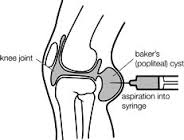
Your doctor may drain the fluid from the knee joint using a needle. This is called needle aspiration and is often performed under ultrasound guidance.
Surgery to Remove the Cyst :
If all else fails, surgery is an option, but a rarely used option. As the baker’s cyst is often secondary to another knee injury,
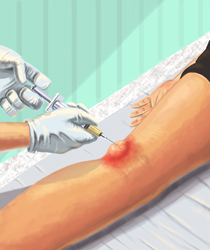
sometimes surgery to the causative injury can help. When internal knee problems and cartilage tears are found, surgery can be the best alternative. The surgeon may remove the swollen tissue leading to the formation of the cyst. Arthroscopic surgery (keyhole) is performed.
Physiotherapy Treatment:
Ultrasound can be used to help increase tissue temperature prior to doing soft tissue massage. A type of ultrasound called phonophoresis can also be used to help decrease inflammation.
iontophoresis is a modality in which an electrical device is used to deliver an anti-inflammatory medication located in an electrode to the region.
Exercises helps to improve flexibility and range of motion in your knee
Massage improve fluid circulation and helps to reduce pain and also reduces fluid sac.
Hot Pack / Cold Pack also helps in reducing pain, muscle spasm and other related symptoms. You can do 2 to 3 times a day at Home.
Hamstring stretches :
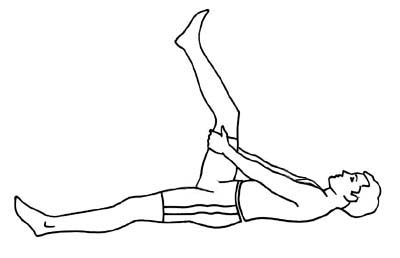
Lie on the floor or bed with both legs bent.
Slowly lift one leg, still bent, and bring your knee back toward your chest.
Link your hands behind your thigh, not your knee, and straighten your leg.
Pull your straight leg back toward your head until you feel the stretch.
Hold for 30 to 60 seconds, then slowly bend your knee and lower your leg back to the floor.
Heel slide:
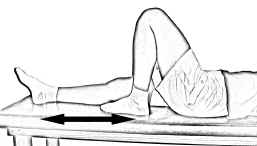
Lie on your back with knees straight.
Slide the affected heel toward your buttock as you bend your knee.
Hold a gentle stretch in this position and then return to original position
Standing calf stretch :
Start by standing close to a wall.
Step forward with one foot and keep both feet pointed toward the wall.
Keep the knee of your back leg straight.
Lean forward toward the wall and support yourself with your arms as you allow your front knee to bend until you feel a gentle stretch along the back of your straight leg.Move closer or farther away from the wall to control the stretch of the back leg.
Wall squat :
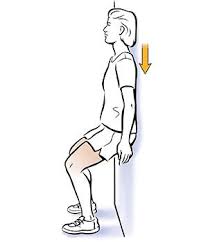
Lean against a wall or a door, so that your feet are about a foot away from you.
Slide your body downward while keeping your back against the wall.
Hold for three seconds, then return back to an upright position.
Straight-Leg Raises (SLR) :

Lay on your back and support your neck with a pillow or neck roll. Bend 1 knee up so your foot is flat and your back is a neutral position (not arched). Keep your arms lying straight and in line with your shoulders.
Straighten the other leg by tightening the muscles on the top of your thigh. Keeping your toes pointed up, lift your leg up to the height of the bent knee. Pause, then slowly lower your leg back down to the start position. Do 10 repetitions of this exercise on each leg, 3 sets once per day. Perform this exercise 2-3 days per week.
Prone Straight Leg Raises :

Lie on your stomach with your legs straight. Tighten the muscles in your bottom and the hamstring of one leg, and lift toward the ceiling. Hold 3-5 seconds, lower, and repeat.
Side lying Hip Abduction :
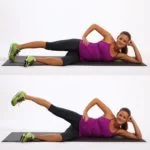
Lay on your side and bend your bottom knee to give you better balance. Support your head with a pillow or towel roll. Straighten the top knee by tightening the muscles on the top of your thigh. Flex your foot so your toes face forward, lift your leg up toward the ceiling, lifting no higher than the line of your body. Pause, then slowly lower your leg back down to the start position. Do 10 repetitions of this exercise on each leg, 3 sets once per day. Perform this exercise 2-3 days per week.
Static quadriceps :

Lay on your back. Place a rolled up towel or a small foam roller beneath the knee. Activate the thigh muscles in order to straighten the knee and hold the contraction for 5 seconds. Release. Repeat 10 times on each side.
sitting quadriceps :
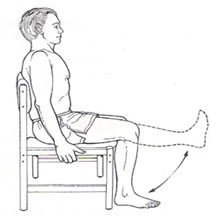
Sit well back in the chair with good posture.
Straighten and raise one leg.
Hold for a slow count to 10, then slowly lower your leg.
Repeat this at least 10 times with each day
Precaution :
Wear the right shoes when you work out.
Warm up properly before you exercise and cool down afterwards.
low-salt diet can help reduce inflammation cautious about overdoing exercise using the hamstring muscles
Avoid any excess aerobics, jogging or weightlifting until the cyst is completely healed.
While resting, apply some ice to the back of your knee to reduce inflammation.
Conclusion
Baker’s cysts are very common and often go away on their own. If you have symptoms, and especially if you have symptoms for more than a few days, see your doctor. Proper treatment and exercise help you recover.

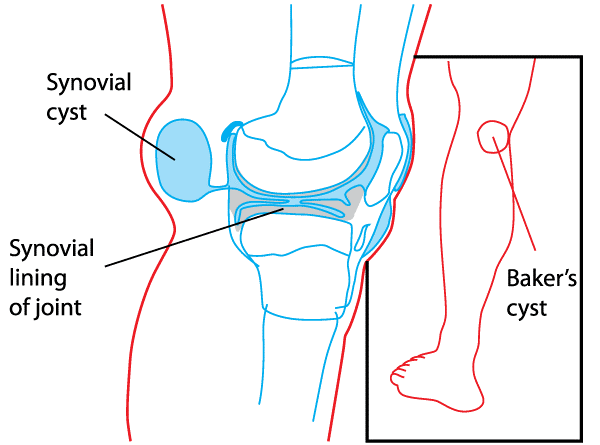
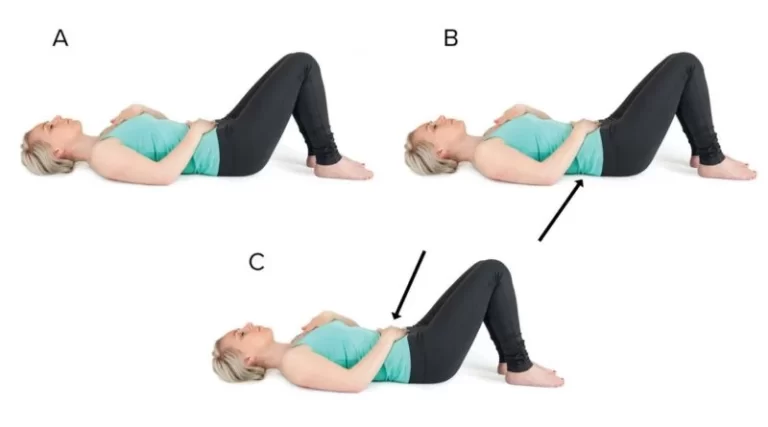
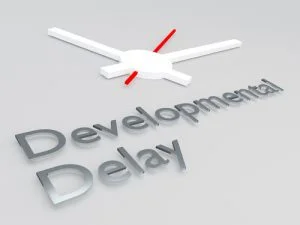
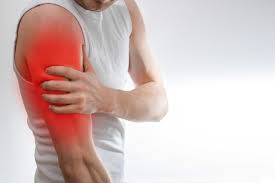
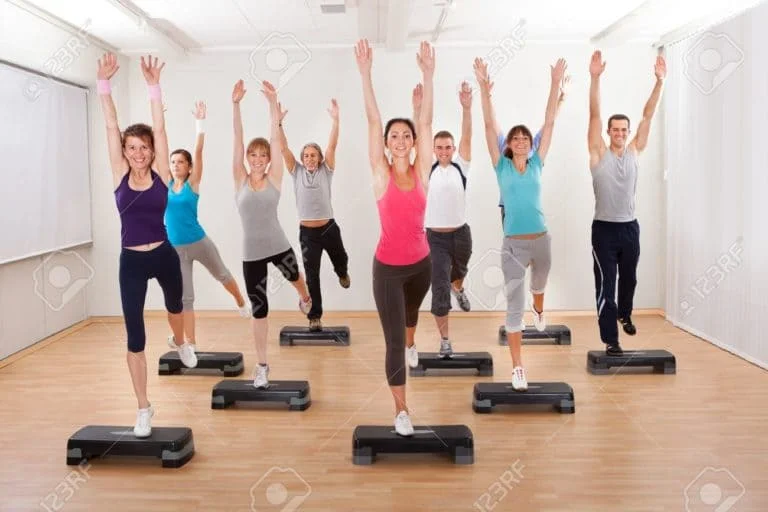

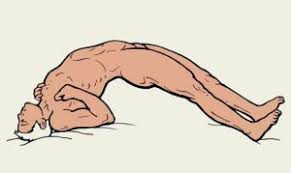
5 Comments